Design and Fabrication of Millimeter-Wave Frequency-Tunable Metamaterial Absorber Using MEMS Cantilever Actuators
Abstract
:1. Introduction
2. Operation Principle and Device Structure
3. Design and Simulation
4. Fabrication Process
5. Experimental Procedures and Results
5.1. Deformation Characteristics of the Released Cantilever Beams
5.2. Experimental Setup and Measurement Results
6. Discussion
7. Conclusions
Author Contributions
Funding
Data Availability Statement
Conflicts of Interest
References
- Watts, C.M.; Liu, X.; Padilla, W.J. Metamaterial electromagnetic wave absorbers. Adv. Opt. Mater. 2012, 24, OP98–OP120. [Google Scholar] [CrossRef] [PubMed]
- Chen, W.T.; Zhu, A.Y.; Sanjeev, V.; Khorasaninejad, M.; Shi, Z.; Lee, E.; Capasso, F. A broadband achromatic metalens for focusing and imaging in the visible. Nat. Nanotechnol. 2018, 13, 220–226. [Google Scholar] [CrossRef] [PubMed] [Green Version]
- Chen, X.; Huang, L.; Muhlenbernd, H.; Li, G.; Bai, B.; Tan, Q.; Jin, G.; Qiu, C.-W.; Zhang, S.; Zentgraf, T. Dual-polarity plasmonic metalens for visible light. Nat. Commun. 2012, 3, 1198. [Google Scholar] [CrossRef]
- Gu, J.; Singh, R.; Liu, X.; Zhang, X.; Ma, Y.; Zhang, S.; Maier, S.A.; Tian, Z.; Azad, A.K.; Chen, H.-T.; et al. Active control of electromagnetically induced transparency analogue in terahertz metamaterials. Nat. Commun. 2012, 3, 1151. [Google Scholar] [CrossRef] [PubMed] [Green Version]
- Zhao, Y.; Askarpour, A.N.; Sun, L.; Shi, J.; Li, X.; Alu, A. Chirality detection of enantiomers using twisted optical metamaterials. Nat. Commun. 2017, 8, 14180. [Google Scholar]
- Soukoulis, C.M.; Linden, S.; Wegnener, M. Negative refractive index at optical wavelength. Science 2007, 315, 47–49. [Google Scholar] [CrossRef] [PubMed]
- Landy, N.I.; Sajuyigbe, S.; Mock, J.J.; Smith, D.R.; Padilla, W.J. Perfect metamaterial absorber. Phys. Rev. Lett. 2008, 100, 207402. [Google Scholar] [CrossRef]
- Liu, X.; Tyler, T.; Starr, T.; Starr, A.F.; Jokerst, N.M.; Padilla, W.J. Taming the blackbody with infrared metamaterials as selective thermal emitters. Phys. Rev. Lett. 2011, 107, 045901. [Google Scholar] [CrossRef] [Green Version]
- Hasan, D.; Lee, C. Hybrid metamaterial absorber platform for sensing of CO2 gas at mid-IR. Adv. Sci. 2018, 5, 1700581. [Google Scholar] [CrossRef]
- Hu, C.G.; Li, X.; Feng, Q.; Chen, X.N.; Luo, X.G. Investigation on the role of the dielectric loss in metamaterial absorber. Opt. Express 2010, 18, 6598–6603. [Google Scholar] [CrossRef]
- Schurigj, D.; Mockb, J.; Justice, J.; Cummerj, A.; Pendrya, B.; Starrand, F.; Smith, D.R. Metamaterial electromagnetic cloak at microwave frequencies. Science 2006, 314, 977–980. [Google Scholar] [CrossRef] [PubMed] [Green Version]
- Holloway, C.L.; Kuester, E.F. A low-frequency model for wedge or pyramid absorber arrays-II: Computed and measured results. IEEE Trans. Electromagn. Compat. 1994, 36, 307–313. [Google Scholar] [CrossRef]
- Du Toit, L.J. The design of Jauman absorbers. IEEE Antennas Propag. Mag. 1994, 36, 17–25. [Google Scholar] [CrossRef]
- Deng, G.; Xia, T.; Yang, J.; Yin, Z. Triple-band polarisation-independent metamaterial absorber at mm wave frequency band. IET Microw. Antennas Propag. 2018, 12, 1120–1125. [Google Scholar] [CrossRef]
- Singh, P.; Amer, S.K.; Chao, L.; Afsar, M.N.; Sonkusale, S. Broadband millimeter wave metamaterial absorber based on embedding of dual resonators. Prog. Electromagn. Res. 2013, 142, 625–638. [Google Scholar] [CrossRef] [Green Version]
- Tao, H.; Landy, N.I.; Bingham, C.M.; Zhang, X.; Averitt, R.D.; Padilla, W.J. A metamaterial absorber for the terahertz regime: Design, fabrication and characterization. Opt. Express 2008, 16, 7181–7188. [Google Scholar] [CrossRef] [PubMed]
- Yao, G.; Ling, F.; Yue, J.; Luo, C.; Ji, J.; Yao, J. Dual-band tunable perfect metamaterial absorber in the THz range. Opt. Express 2016, 24, 1518–1527. [Google Scholar] [CrossRef]
- Ogawa, S.; Kimata, M. Metal-insulator-metal-based plasmonic metamaterial absorbers at visible and infrared wavelengths: A review. Materials 2018, 11, 458. [Google Scholar] [CrossRef] [Green Version]
- Wu, T.; Li, W.; Chen, S.; Guan, J. Wideband frequency tunable metamaterial absorber by splicing multiple tuning ranges. Results Phys. 2021, 20, 103753. [Google Scholar] [CrossRef]
- Kim, H.K.; Lee, D.; Lim, S. Frequency-tunable metamaterial absorber using a varactor-loaded fishnet-like resonator. Appl. Opt. 2016, 55, 4113–4118. [Google Scholar] [CrossRef]
- Thummaluru, S.R.; Chaudhary, R.K. Polarization controllable and wide-angle frequency tunable metamaterial absorber. J. Appl. Phys. 2018, 124, 204901. [Google Scholar] [CrossRef]
- Shrekenhamer, D.; Chen, W.C.; Padilla, W.J. Liquid crystal tunable metamaterial absorber. Phys. Rev. Lett. 2013, 110, 177403. [Google Scholar] [CrossRef] [PubMed]
- Park, J.-H.; Moon, Y.-H.; Baek, C.-W.; Lim, S. Thermal frequency reconfigurable electromagnetic absorber using phase change material. Sensors 2018, 18, 3506. [Google Scholar]
- Wang, B.-X.; Wang, G.-Z. Temperature tunable metamaterial absorber at THz frequencies. J. Mater Sci. Mater. Electron. 2017, 28, 8487–8493. [Google Scholar] [CrossRef]
- Wang, L.; Ge, S.; Hu, W.; Nakajima, M.; Lu, Y. Graphene-assisted high-efficiency liquid crystal tunable terahertz metamaterial absorber. Opt. Express 2017, 25, 23873–23879. [Google Scholar] [CrossRef]
- Zhang, J.; Wei, Z.; Rukhlenko, I.D.; Chen, H.-T.; Zhu, W. Electrically tunable metasurface with independent frequency and amplitude modulations. ACS Photonics 2020, 7, 265–271. [Google Scholar] [CrossRef]
- Huang, C.; Ji, C.; Peng, J.; Yuan, L.; Luo, X. Multifunctional and tunable radar absorber based on graphene-integrated active metasurface. Adv. Mater. Technol. 2021, 6, 2001050. [Google Scholar] [CrossRef]
- Huang, C.; Liao, J.; Ji, C.; Peng, J.; Yuan, L.; Luo, X. Graphene-integrated reconfigurable metasurface for independent manipulation of reflection magnitude and phase. Adv. Opt. Mater. 2021, 9, 2001950. [Google Scholar] [CrossRef]
- Huang, C.; Song, J.; Ji, C.; Yang, J.; Luo, X. Simultaneous control of absorbing frequency and amplitude using graphene capacitor and active frequency-selective surface. IEEE Trans. Antennas Propag. 2021, 69, 1260–1272. [Google Scholar] [CrossRef]
- Huang, C.; Yang, J.; Ji, C.; Yuan, L.; Luo, X. Graphene-driven metadevice for active microwave camouflage with high-efficiency transmission window. Small Methods 2021, 5, 2000918. [Google Scholar] [CrossRef]
- Hu, F.; Xu, N.; Wang, W.; Wang, Y.; Zhang, W.; Han, J.; Zhang, W. A dynamically tunable terahertz metamaterial absorber based on an electrostatic MEMS actuator and electrical dipole resonator array. J. Micromech. Microeng. 2016, 26, 025006. [Google Scholar] [CrossRef]
- Liu, M.; Susli, M.; Silva, D.; Putrino, G.; Kala, H.; Fan, S.; Cole, M.; Faraone, L.; Wallace, V.P.; Padilla, W.J.; et al. Ultrathin tunable terahertz absorber based on MEMS-driven metamaterial. Microsyst. Nanoeng. 2017, 3, 17033. [Google Scholar] [CrossRef] [PubMed] [Green Version]
- Xu, J.; Jia, D.; Liu, Y.; Tian, Y.; Yu, X. Tunable terahertz metamaterial absorber actuated by thermomechanical bimaterial microcantilevers. Opt. Express 2020, 28, 10329–10336. [Google Scholar] [CrossRef] [PubMed]
- Kang, T.J.; Kim, J.G.; Kim, J.H.; Hwang, K.C.; Lee, B.W.; Baek, C.-W.; Kim, Y.K.; Kwon, D.; Lee, H.Y.; Kim, Y.H. Deformation characteristics of electroplated MEMS cantilever beams released by plasma ashing. Sens. Actuator A Phys. 2008, 148, 407–415. [Google Scholar] [CrossRef]
- Baek, C.-W.; Kim, Y.-K.; Ahn, Y.; Kim, Y.H. Measurement of the mechanical properties of electroplated gold thin films using micromachined beam structures. Sens. Actuator A Phys. 2005, 117, 17–27. [Google Scholar] [CrossRef]
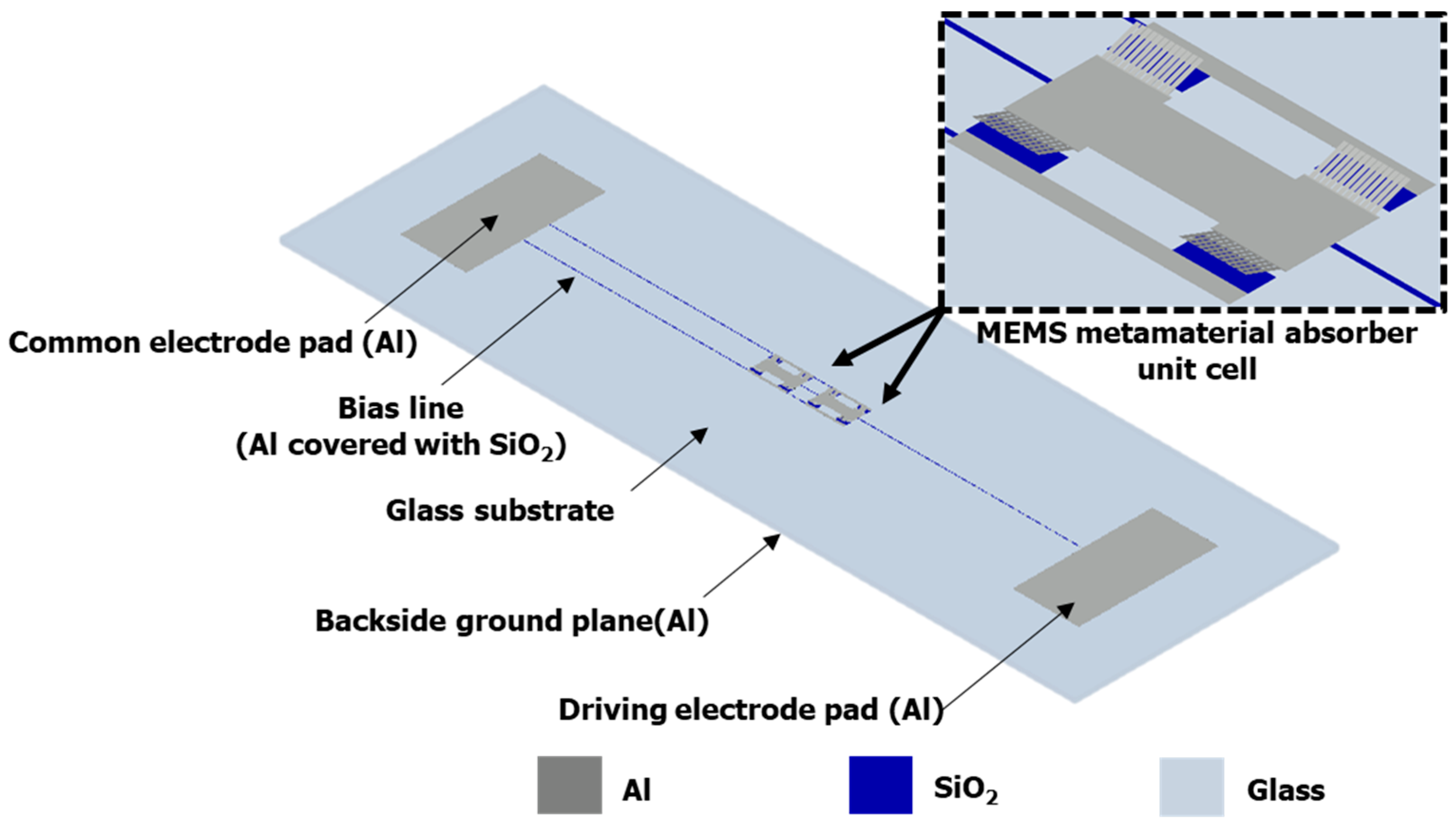
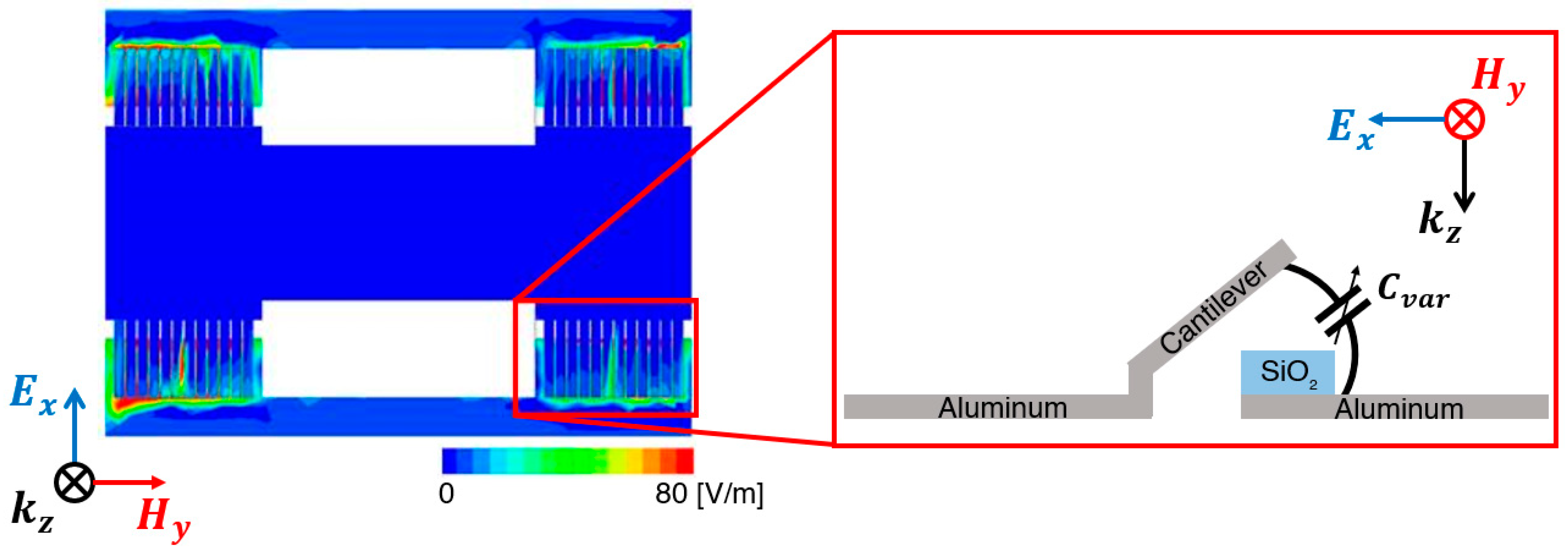



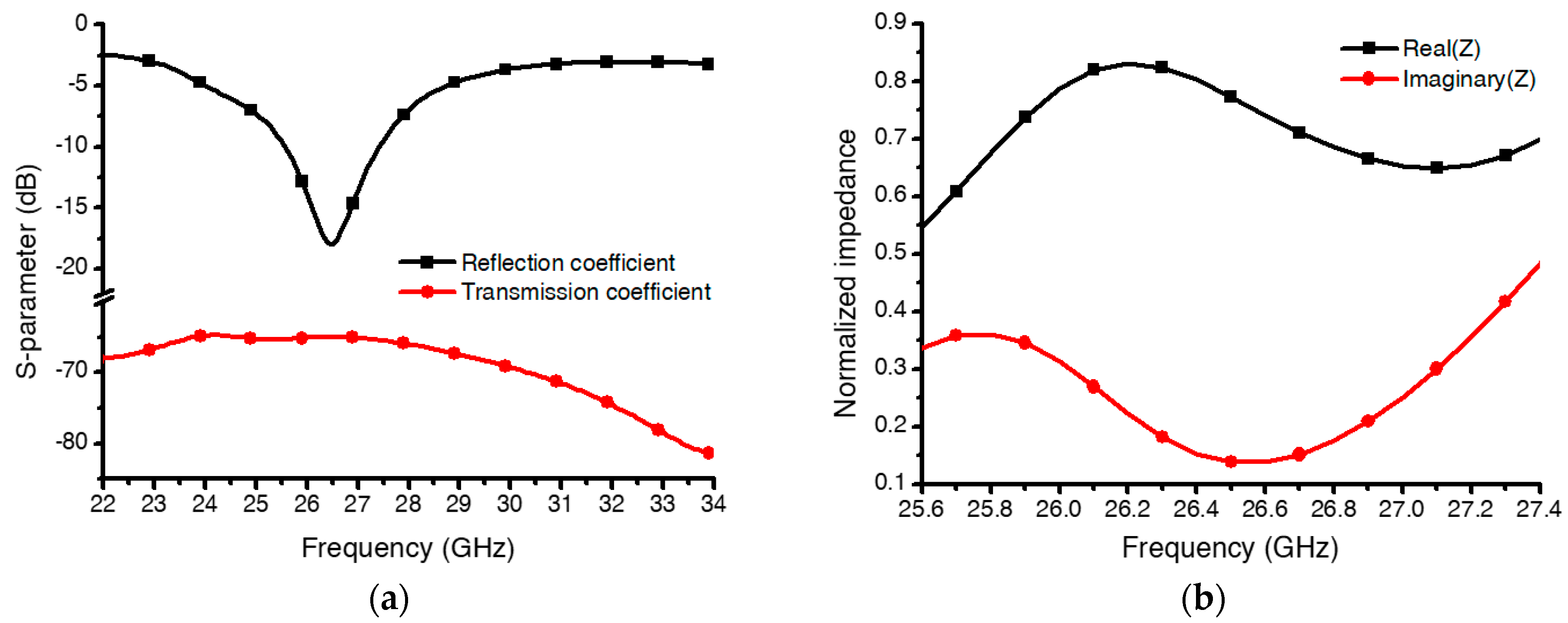
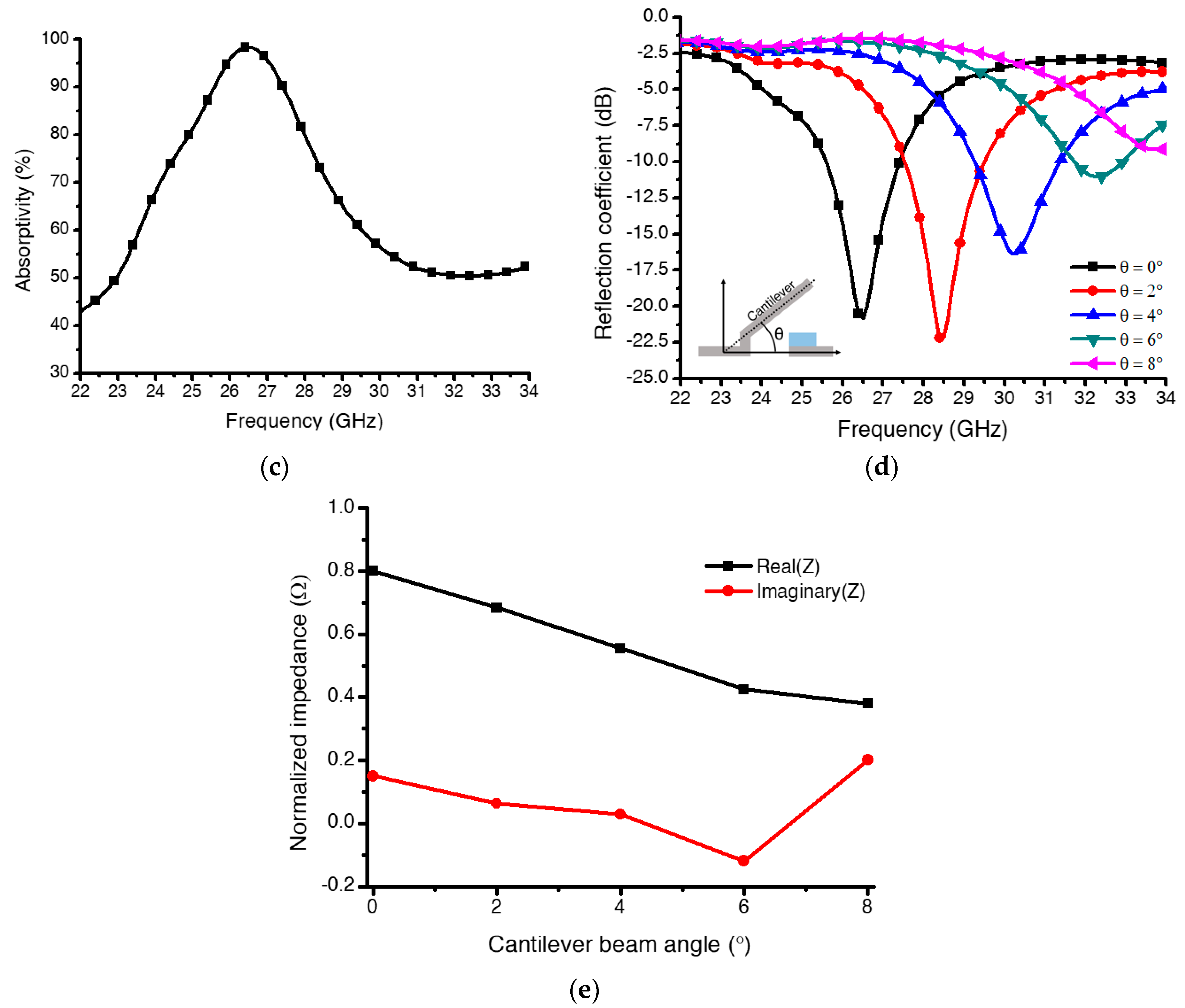
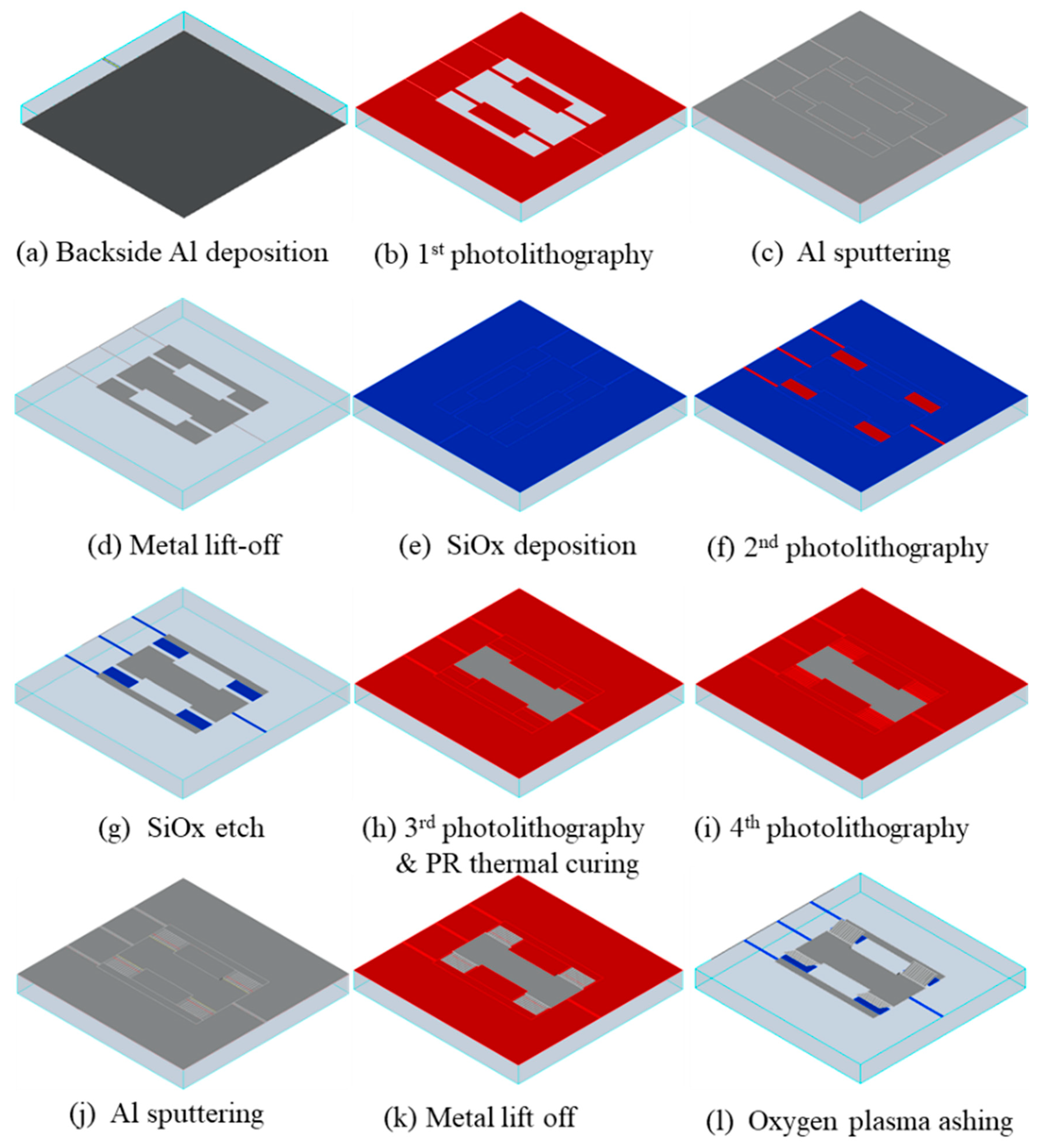


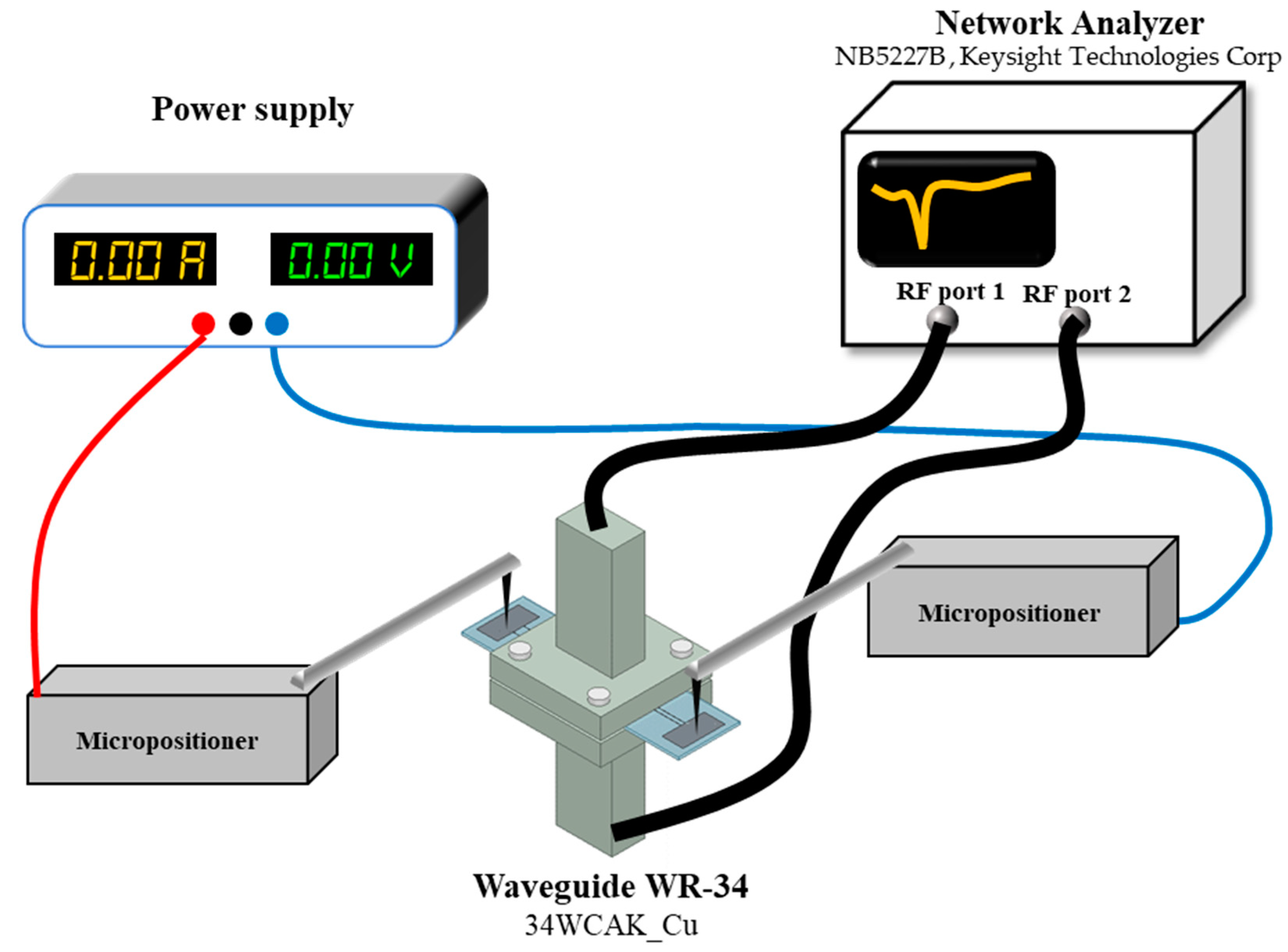
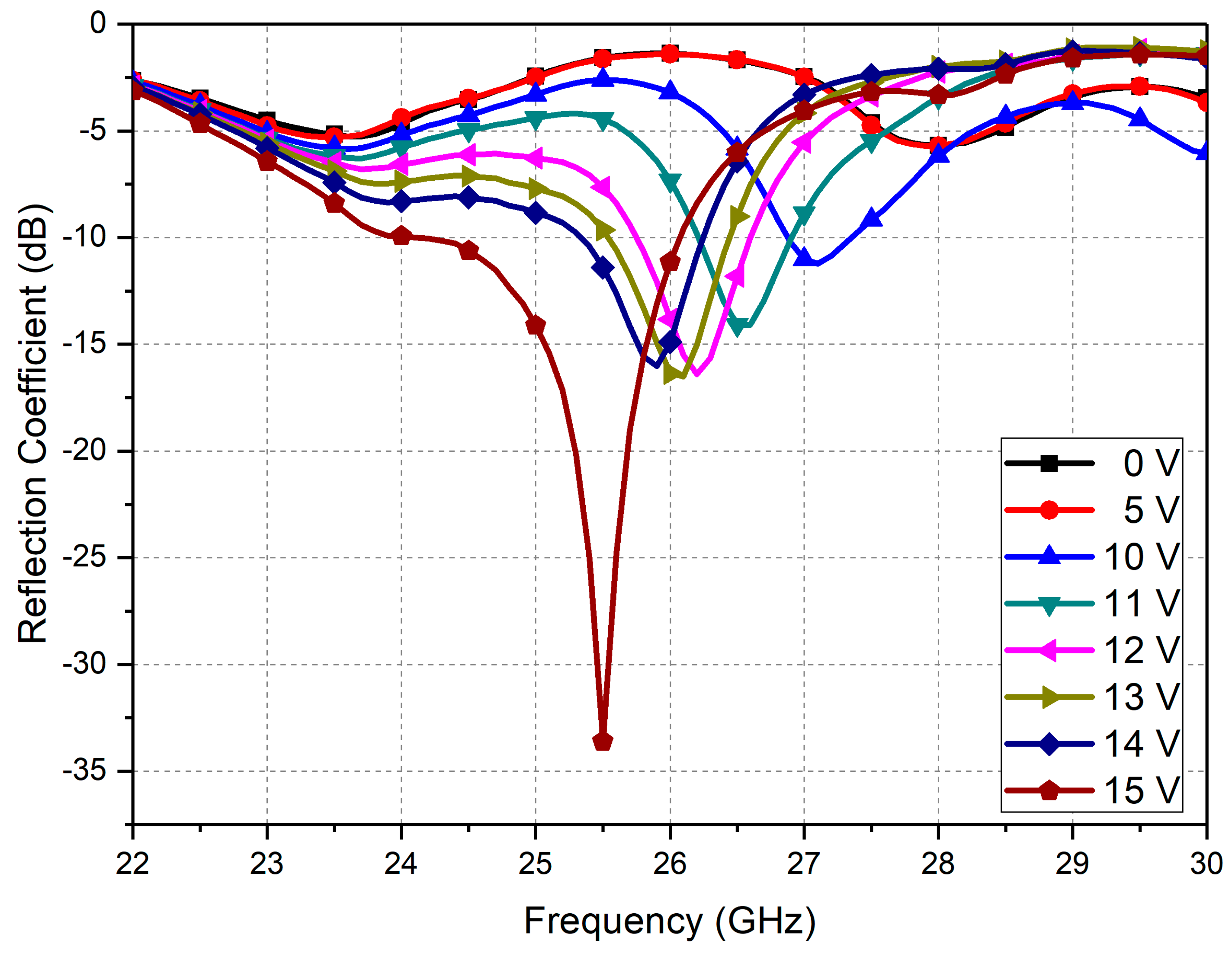
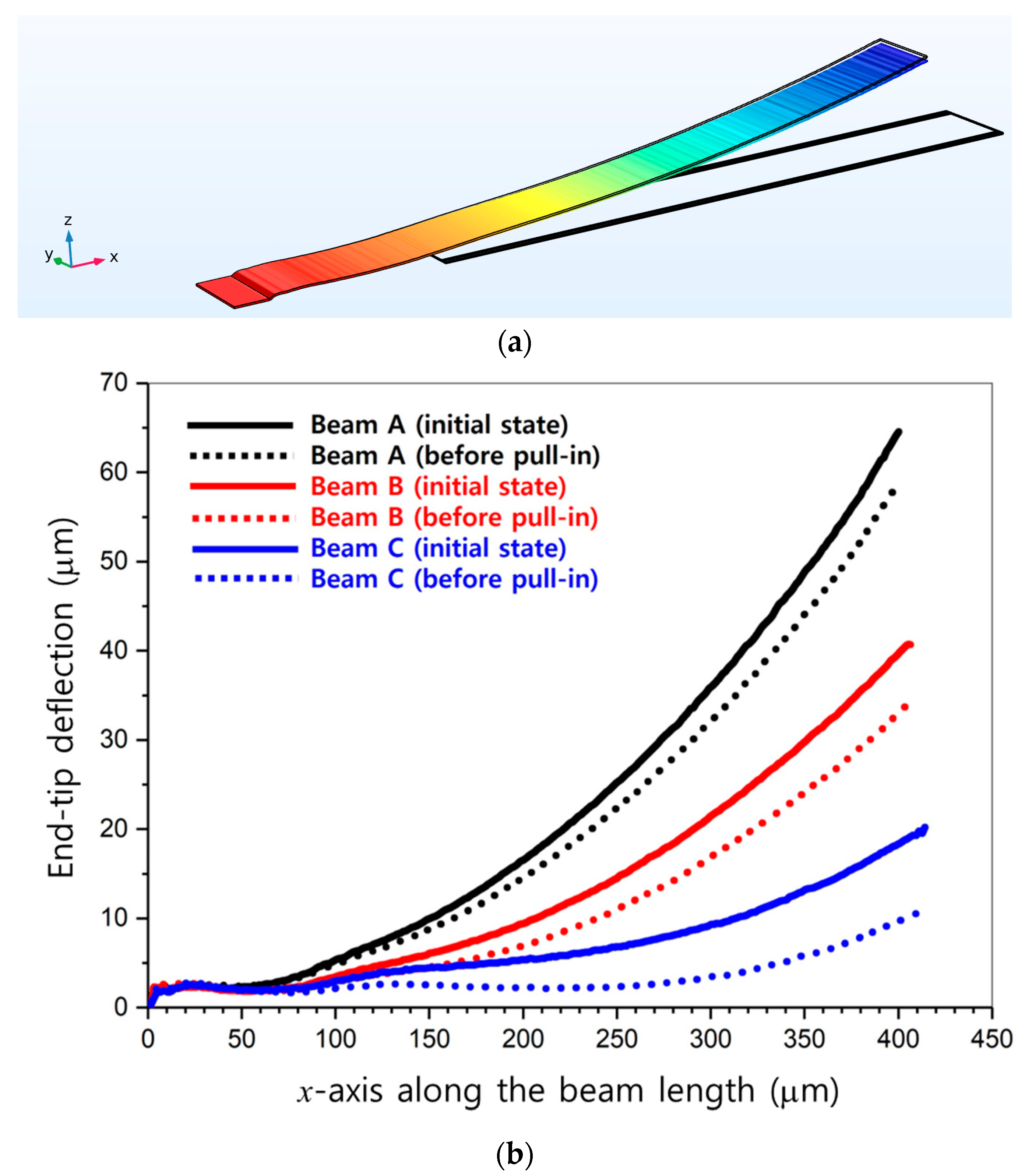
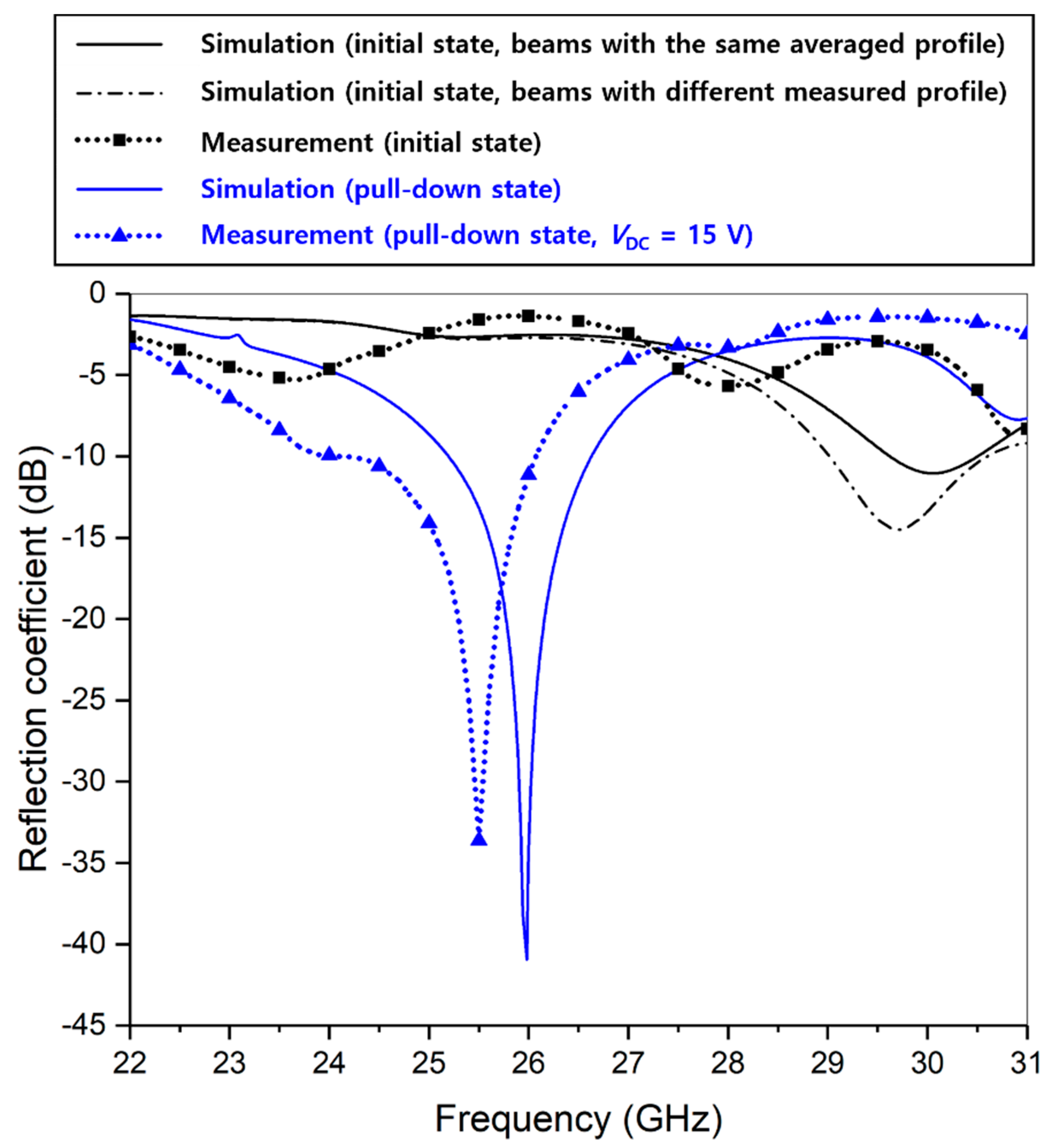
| Symbols | Value | Description |
|---|---|---|
| d | 40 μm | The width of the bias line |
| l1 | 200 μm | The edge length of the unit cell |
| l2 | 800 μm | The middle length of the anchor |
| l3 | 1000 μm | The length of the anchor |
| le | 300 μm | The length of the silicon oxide film |
| lb | 400 μm | The length of the cantilever beam |
| w | 3 mm | The width of the unit cell |
| w1 | 45 μm | The margin of the array edge |
| wb | 50 μm | The width of the cantilever beams |
| s | 10 μm | The space between cantilever beams |
| tb | 1000 nm | The thickness of the cantilever beam |
| tox | 500 nm | The thickness of the silicon oxide |
| te | 500 nm | The thickness of the bottom electrode |
| tg | 200 nm | The thickness of the Al ground plane |
| h | 500 μm | The thickness of the glass substrate |
| Applied Voltage | Resonant Frequency | Reflection Coefficients | Absorptivity |
|---|---|---|---|
| 0 V | 28.0 GHz | −5.68 dB | 72.9 % |
| 5 V | 27.9 GHz | −5.70 dB | 73.0 % |
| 10 V | 27.1 GHz | −11.23 dB | 92.5 % |
| 11 V | 26.6 GHz | −14.08 dB | 96.1 % |
| 12 V | 26.2 GHz | −16.40 dB | 97.7 % |
| 13 V | 26.1 GHz | −16.50 dB | 97.8 % |
| 14 V | 25.9 GHz | −16.02dB | 97.5 % |
| 15 V | 25.5 GHz | −33.60dB | 99.9 % |
Publisher’s Note: MDPI stays neutral with regard to jurisdictional claims in published maps and institutional affiliations. |
© 2022 by the authors. Licensee MDPI, Basel, Switzerland. This article is an open access article distributed under the terms and conditions of the Creative Commons Attribution (CC BY) license (https://creativecommons.org/licenses/by/4.0/).
Share and Cite
Chung, M.; Jeong, H.; Kim, Y.-K.; Lim, S.; Baek, C.-W. Design and Fabrication of Millimeter-Wave Frequency-Tunable Metamaterial Absorber Using MEMS Cantilever Actuators. Micromachines 2022, 13, 1354. https://doi.org/10.3390/mi13081354
Chung M, Jeong H, Kim Y-K, Lim S, Baek C-W. Design and Fabrication of Millimeter-Wave Frequency-Tunable Metamaterial Absorber Using MEMS Cantilever Actuators. Micromachines. 2022; 13(8):1354. https://doi.org/10.3390/mi13081354
Chicago/Turabian StyleChung, Myungjin, Heijun Jeong, Yong-Kweon Kim, Sungjoon Lim, and Chang-Wook Baek. 2022. "Design and Fabrication of Millimeter-Wave Frequency-Tunable Metamaterial Absorber Using MEMS Cantilever Actuators" Micromachines 13, no. 8: 1354. https://doi.org/10.3390/mi13081354
APA StyleChung, M., Jeong, H., Kim, Y.-K., Lim, S., & Baek, C.-W. (2022). Design and Fabrication of Millimeter-Wave Frequency-Tunable Metamaterial Absorber Using MEMS Cantilever Actuators. Micromachines, 13(8), 1354. https://doi.org/10.3390/mi13081354







